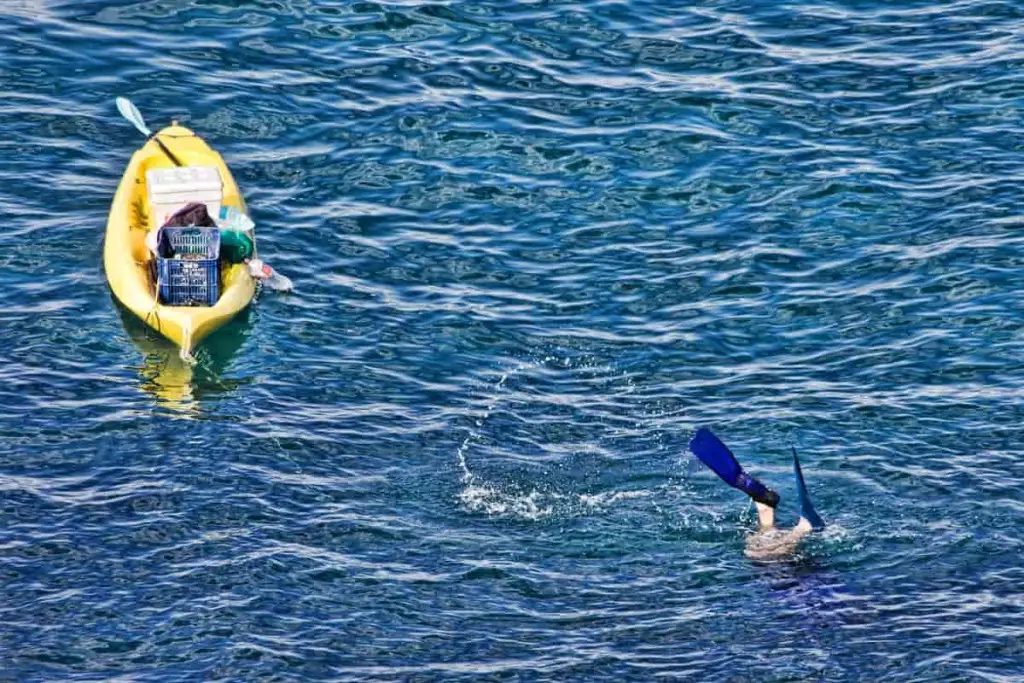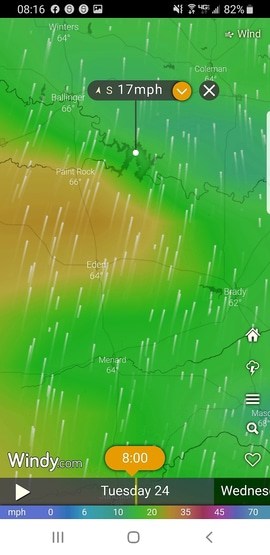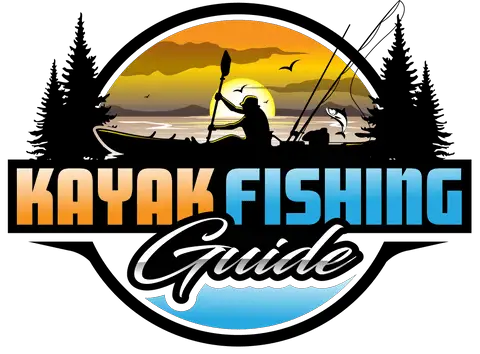
When you don’t own or have access to a dive boat for spearfishing, very often, a stable kayak is the next best thing! In fact, kayaks are beginning to show up on reefs and inland lakes more often than you’d think!
Whether you desire to use your current fishing kayak and get into spearfishing, or you’re an experienced, seasoned spearfishing divemaster wanting to get a kayak, there are several things to be considered when using a kayak to spear from.
Kayaks are easier to transport and can be launched from many more locations than a dive boat. Spearfishing from a kayak, you can reach the reefs that divers from shore cannot. You’ll have to be more selective in the gear you take as there is less storage for dive gear, clothing, food, and water.
Kayak diving has been popular in southern California since before the mid-nineties. Long before dive boats became popular, tribal canoes have been used for centuries to access their lagoons and reefs when diving to the seafloor for their food sources.
Spearfishing from kayaks is a viable alternative to expensive dive boats, and many divers are having great success and fun with the ability to reach more diving areas!
With a kayak, you won’t need to fight or swim through riptides and currents. And you won’t have to use air from your tanks by swimming from the beach or shore to your spearing spots.
Which kayak you choose to dive from is an important consideration as there are several great kayaks to choose from. To start, let’s go over some key considerations when choosing a spearfishing or diving kayak.
Kayaks as Diving Platforms
Dive kayaks are an excellent choice for spearfishing. When you want to dive a reef that is too far to swim to from the beach, yet really to close to charter or take a powered dive boat, a diving platform kayak is an answer!
A good paddling sit-on-top kayak will easily glide you through the surf line, and once past it, you can go miles in either direction with relative ease! When you get out beyond the breakers, the same kayak will serve you as an ironclad diving platform.
A sit-on-top kayak is going to be your kayak of choice. It’s simply the easiest way to enter the water and climb back on board the kayak. Sit-on-tops can be either rigid kayaks or inflatable kayaks.
Throughout your day of spearfishing, you’ll be able to hang out on your kayak and take a few breaks, swap out an air tank, eat lunch, and even work on your tan!
You can purchase a quality kayak designed for open water for what would be spent on just the fuel expenses for a small dive boat! And this isn’t taking into account the insurance, taxes, maintenance, and trailer costs for a small dive boat!
If you already own or have access to a kayak, the one you have will no doubt be the one you’ll start out with. If you’re looking for your first kayak diving platform for spearfishing, you’ll want to keep some of the following points in mind when choosing one.
The Size of Kayak Can Matter
When diving from a kayak, like anything else, size is everything up to a certain point.
A kayak needs to be large enough to withstand making it’s way through the surf if you’re heading offshore. When inshore, it also needs to be large enough to handle water chop and waves it may encounter.
Shorter kayaks will better handle the surf and not be as cumbersome as a longer kayak when coming in and heading out to sea. However, a longer kayak will paddle faster and track better than the shorter version.
Shorter length kayaks may be fine on protected waters, but they are not always good for open water and the ocean. I would recommend a good all-around length of a kayak as a dive platform in the fourteen-foot mark.
Keep in mind that a larger kayak will also have the capacity to carry more weight than a shorter one.
One of the best reasons to spearfish from a kayak is you can reach and access many areas a dive boat or swimmer from the shore never could! A kayak allows you more opportunities to spearfish in waters others cannot.
Kayak Stability is Important
A kayak’s stability will allow you to stand up and even walk around on some kayaks! There are two forms of stability to be concerned with, initial and secondary.
The initial stability in a kayak comes from the kayak’s design and the forces exerted upon it. For example, the wider the kayak design from its center keel line, the more stability it will have.
What is known as secondary stability is the side-to-side movement from yourself leaning over the sides, or effects from the currents or winds.
Once you arrive at your dive destination, you will be sliding over the side of the kayak to enter the water. A kayak must be stable enough to allow you to not only slide off the side but to climb back in as well easily.
A shorter and wider kayak is often more stable than a longer length kayak. Keep in mind if you decide to go with the shorter kayak you will be giving up some storage capacity and ability to carry more gear with you.
Another caveat of the shorter kayaks is the weight capacity rating. They are rated less than larger kayaks and you’ll want to include your body weight in this capacity figure too!
Read more on weight capacity at my Kayak Weight Limits Explained for Larger Anglers!
Kayak stability also comes into play because you’ll need to leave gear in the kayak while you’re spearfishing. So the kayak needs to be stable enough to for you to enter and exit with all your gear, and remain afloat while you’re spearing down below it.

If you’d like to have more information on a fishing kayak’s stability, check out my article How Stable Is a Fishing Kayak?.
Kayak Storage Can Be Optimized
You’re going to need storage for all the gear you take with you, and certainly larger kayaks afford more storage. If you’re like me, what you’ll find is you’ll always want to bring more gear with you, then you won’t use it all! Eventually, you’ll learn what you actually need and leave the stuff you don’t use at home!
Some of the gear you’d normally carry in a bag on a dive boat, you will most likely wear while paddling out to your dive hole. You can wear the bottom half of your wetsuit and boots or pull your top off while paddling out if it’s a warm day!
Many of the modern sit-on-top kayaks of today have at least one or more watertight compartments within reach of your seat. Keep your lunch, spare clothing, electronics, and cameras in these hatches. I’d certainly recommend a good dry bag as added insurance as seals can sometimes fail with prolonged use! Click here to see a variety of dry bags available on Amazon!
There will also be storage “wells” in the fore and aft sections of the kayak. These are a super place to stack your diving gear and items you don’t mind getting a little splash on now and then.
All of these storage wells on newer model kayaks are deep enough to accommodate most of your heavier gear. You can stack and lay your gear down, then use a good strap to tighten them down and secure the load.
Strapping down a plastic milk crate in the storage well is another great use of the space behind your seat. You can then place all of your smaller items inside the crate.
I would definitely recommend keeping your heavier gear closer to the kayak deck to keep your center of gravity lower. With a lower center of gravity, your risk of capsizing is greatly reduced!
Another option for storage is carrying a cooler with you. How Do You Carry a Cooler on a Fishing Kayak? will give you a ton of great information!
Gear Needs for Beginning Spearfishermen
No matter what the hobby or pastime is, we all love to research the latest and get new gear! Spearfishing is not any different!
These are some of the basic requirements to get started spearfishing you’re going to want to have:
- Speargun
- Swim fins
- Diving mask
- Snorkel
- Scuba tanks
- Float, Dive Flag, Line
- Dive knife
- Wetsuit
- Booties for your fins if needed
- Weighted belts and weights
The list above is to get you started spearfishing safely. You can certainly spend thousands of dollars more on upgraded and costly equipment as your skills grow within the sport.
Jim Russell from the Jackson Kayak Team has an awesome video on much of the basic gear you’d need for spearfishing.
Food and Water Requirements
When planning on being out on the water for extended periods during the day, having plenty of water and nutrition is going to be key to your enjoyment and safety!
You may go through quite a bit of water on hotter days, and having some fruits, protein bars, sandwiches, beef jerky, etc., will keep you alert and on your toes.
Plus, whenever I’m hungry or thirsty and don’t have anything with me, or I’ve eaten and drank it all, it kind of ruins the day for me. I’m thinking more about the food and drink I don’t have with me and not focusing on what I am doing at the time.
Have a Thermos With a Warm Beverage
Even on a nice day, if you’ve been in the water for a long period, you can become a bit cold. Hypothermia is when your body loses heat faster than it can produce it. The average body temp is 98.6 F, and hypothermia begins when it falls below 95 F.
Laying back on your kayak, rolling with the subtle ocean movements after a long dive with a cup of warm tea or coffee can be relaxing and warm your insides!
Bring Plenty of Drinking Water
Even in the water, you’re going to perspire and dehydrate while you’re swimming! Keeping hydrated is important to your safety and keeps your body in top-notch condition.
According to the American Council on Exercise, you should hydrate and drink plenty of water before, during, and after exercise. They recommend you drink the following:
- Drink 17 to 20 ounces of water two hours before the start of the exercise.
- Drink 7 to 10 ounces of fluid every 10 to 20 minutes during exercise.
- Drink 16 to 24 ounces of fluid for every pound of body weight lost after exercise.
Water can easily be carried along with you in a plastic Nalgene bottle or two. When I’m out on my kayak, I’ll often bring along a gallon of water in a washed out plastic milk jug.
Foods to Bring on a Kayak
Bring any foods you enjoy!
I like to bring Power Bars, Snickers candy bars, and apples. It doesn’t bother an apple to become a little wet, and the candy bar wrappers are usually water repellent. Plus, they’ll fit easily in a small Tupperware container!
If you tend to get a muscle cramp from time to time, bring along some bananas. I know bananas are considered bad luck on a boat, but they are filled with potassium, and they’ll relieve your cramping after a long day!
Sandwiches in Ziploc baggies are great, as are slices of Summer Sausage and cheeses.
Some divers cannot eat or drink while they’re diving, but the ability to take in calories and your body digesting foods will not only generate body heat, it will fuel your body too!
Weather Conditions
It doesn’t matter if you’re inland or out on the ocean, or in a protected bay. For your own safety or those in your group, you must keep an eye on the weather when you’re out on a kayak!
Weather systems can change and turn on you at a moment’s notice. I’ve been on the water a few miles from my truck, and all of a sudden, without warning, a blast of wind comes over the hill, and you’re paddling like mad to get back or at least to the shore for safety.
Watch the Wind and Clouds
By keeping an eye on the wind and clouds, you can pretty much tell when the weather is getting ready to change for the worse. You can usually feel a drop in the temperature that tells you of an approaching weather event.
Clouds begin to form or rise up on the horizon, temperature begins to drop and the wind picks up, you had better be heading toward the shore soon!
A fantastic wind app I use to check wind speed and patterns is called Windy. I have it on my cell phone, and it can also be accessed on your desktop or tablet! Best of all, there is a FREE version!

A good rule of thumb is if the wind is below 12 MPH, you should be good to get onto the water without much too much concern. Over 12 MPH, you may want to check the weather reports before you head out and err on the conservative side.
Safety
Being safe while out on the water is paramount to anything else. You should never go out onto the water in a kayak without wearing a PDF life jacket. My favorite and the most comfortable PFD I’ve worn is the NRS Chinook Fishing PFD Life Jacket found on Amazon!
Keep your electronics and cell phone dry with a waterproof storage box that will float if you happen to capsize. It’s also a good idea to keep your vehicle keys separate as well.
Waterproof boxes can be expensive, an alternative I’ve used is a plastic Nalgene water bottle you can find in the sporting good stores for a few dollars.
Not only will your cell phone and small electronic gear fit inside, but it is also waterproof and will float too.
Make certain to tell someone where you’re going, even if you’re heading out with a buddy. If bad weather swamped your kayak or you needed to head to the nearest shore, someone would know to look for you if you’re not back by a certain time.
A good rule of thumb is the 120 Rule for wearing a wetsuit. If the ambient air temperature and water temperature combined is less than 120, definitely wear a wetsuit when spearfishing.
If you’re out with a buddy and he has his kayak, it is a good idea to take a length of rope in case one of you loses a paddle. I like to carry bungee cords to strap gear down, and in a pinch, a bungee cord makes a good towing strap.
Attach the bungee cord to the back of your kayak and the front handle of your buddy’s kayak, and you have an easy way to help tow him in!
Spearfishing from a kayak is a great and inexpensive way to reach some wonderful reef fishing! More and more people turn to kayaks to reach their fishing destinations because they’re relatively inexpensive, easy to transport, and make an excellent diving platform!
Have fun, and stay safe out there!
